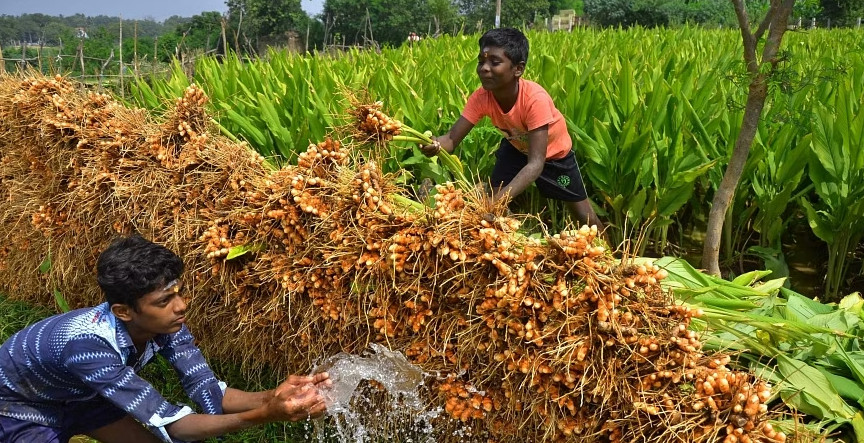Thriving in warm, sunny climates, turmeric farming involves cultivating the turmeric plant for its vibrant orange rhizomes, the source of the popular spice. This labor-intensive process requires well-drained soil, careful watering, and harvesting the mature rootstocks after nearly a year.
Turmeric, a golden-hued spice hailed for its culinary, medicinal, and cultural significance, has been revered for centuries. Native to the lush monsoon forests of Southeast Asia, turmeric, scientifically known as Curcuma longa, is a perennial herb celebrated for its underground rhizomes. Belonging to the same botanical family as ginger, turmeric thrives in hot, humid tropical climates, offering a vibrant addition to gardens and a plethora of health benefits and economic opportunities for cultivation.
Turmeric: A Treasure Trove of Health and Culinary Benefits
Beyond its striking appearance and distinct flavor, turmeric boasts a rich tapestry of medicinal properties. Traditionally used in ancient healing practices, this potent herb is renowned for alleviating various ailments, including liver disorders, ulcers, skin conditions, and joint inflammation. Recent scientific research has underscored turmeric’s effectiveness in combating inflammation, aiding digestion, and even potentially preventing certain types of cancer.

Turmeric is a prized ingredient in culinary realms, lending its vibrant yellow hue and distinctive flavor to many dishes. Turmeric infuses words with color and flavor depth, constituting a significant portion of curry powder. Furthermore, it serves as a natural food dye, replacing artificial additives, and imparts a subtle yet distinctive flavor when wrapped around fish during cooking.
Turmeric Farming: A Step-by-Step Guide
Climate and Soil Requirements
Turmeric thrives in diverse tropical conditions, from sea level to elevations of 1500 meters, with temperatures ranging between 20-35°C. Ideally, it requires an annual rainfall of 1500mm or more, though supplementary irrigation can be employed in drier regions. While turmeric can adapt to various soil types, it flourishes in well-drained sandy or clay loam soils with a pH range of 4.5-7.5.
Preparation of Land
The land preparation process begins with the onset of early monsoon showers. The soil is cultivated to achieve a fine tilth through a series of deep ploughings. Beds of suitable dimensions are then prepared, with spacing between beds to facilitate optimal growth conditions for turmeric plants.
Seed Selection and Planting
Selecting high-quality seed rhizomes is crucial for successful turmeric cultivation. Whole or split mother and finger rhizomes are commonly used for planting. These rhizomes are placed in prepared pits filled with organic compost or cattle manure, ensuring adequate spacing to accommodate plant growth.
Manuring and Fertilizer Application
To enhance soil fertility and support robust plant growth, a combination of farmyard manure or compost, along with appropriate fertilizers, is applied. This includes a balanced mix of nitrogen, phosphorus, and potassium, supplemented with micronutrients like zinc. Integrated approaches involving organic manures and biofertilizers further optimize nutrient uptake and soil health.
Mulching and Irrigation
Mulching, particularly with green leaves, serves multiple purposes, including moisture retention, weed suppression, and soil temperature regulation. Regular irrigation, tailored to soil and weather conditions, is essential for sustaining optimal plant growth and maximizing yield potential.
Integrated Pest and Disease Management
Turmeric cultivation is susceptible to various pests and diseases, necessitating proactive management strategies. From leaf blotch and rhizome rot to nematode infestations and insect pests like shoot borers and rhizome scales, diligent monitoring and timely interventions are paramount to safeguarding crop health and productivity.
Harvesting and Post-Harvest Handling
Turmeric reaches harvest readiness approximately 7 to 10 months after planting, signaled by drying plants and stems. Harvesting involves carefully digging out rhizome bunches and thorough cleaning and curing processes to preserve quality and enhance storability for future use or marketing.
Unlocking the Economic Potential of Turmeric Cultivation
Beyond its intrinsic value as a versatile spice and medicinal herb, turmeric cultivation holds significant economic promise for farmers and agricultural stakeholders. With increasing global demand driven by growing awareness of its health benefits and culinary versatility, turmeric presents lucrative commercial production and export opportunities.
The Bottom Line
Turmeric is a shining example of nature’s bounty, offering a treasure trove of health benefits, culinary delights, and economic opportunities. Through diligent cultivation practices, integrated pest and disease management, and strategic marketing initiatives, turmeric promises farmers prosperity while enriching global markets with its golden allure. Embracing the art and science of turmeric cultivation unlocks economic potential and contributes to the holistic well-being of individuals and communities worldwide.
See Also:
- Mung Bean Farming and Production Guide
- From Seed to Supermarket: Your Guide to Onion Farming in the Philippines
- Why Onions in the Philippines are So Expensive
- Soybean Farming and Production Guide
- The Potential Profit of Rabbit Farming in the Philippines
